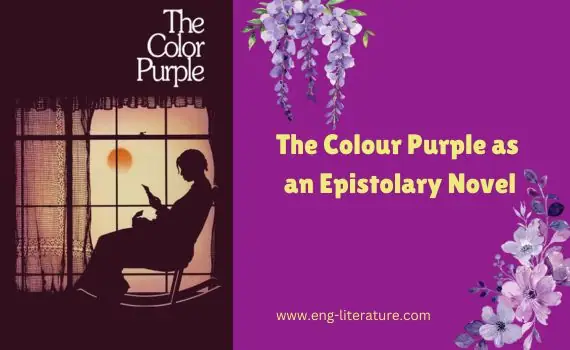Alice Walker’s The Color Purple (1982) is written in an epistolary style. The epistolary novel, derived from the word “epistle” (meaning “letter”), is a novel made up of letters, written and exchanged among the major characters. The events are exposed through these correspondences and diaries. The epistolary style is not a new technique of writing.
Though the style was old fashioned when Alice Walker wrote The Color Purple, Walker intends to use it for multi-faceted purposes. The confessional nature of this style of writing provides the author with a means by which she can make the reader identify with the suffering of the writer of the letter, since the letter reflects the inner thoughts and the psychology of its writer and represents his/her point of view.
Celie is an uneducated girl, who can barely write, living in rural Georgia. She is violated and silenced by her step-father, Alphonso, a gothic experience for a fourteen years old girl, who believes that her step-father is her biological parents. Alphonso terrifies her after his physical attack on her, and then silences her in order to maintain the secrecy of his crime. He threatens her:
“you better not never tell nobody but God. It’d kill your mammy”. As a result, she is rendered “voiceless and thus powerless”
Unable to put an end to her psychological tension and feelings of guilt over the incestuous abuse of her alleged father, and having no one to complain to, Celie starts to write letters to ease her suffering. Terrified by the experience, she cannot but follow Alphonso’s threatening remarks of telling nobody, but God. Therefore, her first epistles are addressed to God and represent her prayers to Him. Walker states in an interview that Celie’s letters are necessary in her search for psychological purgation and her need to break from the silent existence into which her step-father forces her:
“Celie is able to write, ‘Dear God, this has happened to me and I have to tell somebody and so I write to you”.
Celie’s step-father, besides abusing her, deprives her from any opportunity for a normal life or any chance to improve herself. Celie sadly remembers how her “Pa” deprives her from having a chance to be educated:
“The first time I got big Pa took me out of school. He never care that I love it. Nettie stood there at the gate holding tight to my hand. I was all dress for first day. You too dumb to keep going to school, Pa say”.
Celie’s first letter reflects, not only her unlettered style, but also shows her as being helpless, frightened, and ruined, unable to address her misery only to God. Her journey towards womanhood is a difficult one. What intensifies her situation is her inability to find support and protection in the figure of her sickly mother, who dies shortly after Celie is physically abused and impregnated. Furthermore she is traumatised by her thwarted maternal experience, when her babies are taken from her by her villainous step-father, who grants them to other people, whom she does not know.
Through the use of the epistolary style, Celie is able to reveal her inner feelings and psychological wounds, triggered by violence, both verbal and physical. Her sense of loss and oppression finds expression in her letters to God, then to her sister, and finally she acquires maturity into a strong female. Consequently, she becomes the mouthpiece of all victimized black females and a model for oppressed women who need to break the handcuffs of domestic and racial subjection.
In her letters, Celie portrays the emotional allegiance and the bond of solidarity that she forms with powerful black female characters, like Nettie, Shug, a jazz and blues singer, and Sofia, her step-son’s defiant wife. These women provide her with self-confidence and help her achieve maturity and independence.
Nettie’s letters to Celie are also fundamental in her sister’s recovery from trauma and her substantial transformation. These letters include her account of her cultural and religious experience in Africa as a missionary, and her discovery of Celie’s two lost children, Adam and Olivia, whom she takes under her wings. It is also through her communication with her sister via letters that Celie discovers the reality of their abusive step-father. Nettie informs Celie that their biological father has been lynched by the racial whites, and that their mother has been married to that brutal man whom they believe to be their “Pa”
Initially, Celie’s letters to God are unsigned, which testifies to her identity crisis. As she starts writing to her sister and gradually gains self-confidence, Celie’s ability to communicate develops and the intensity of her traumatic feelings decreases:
“I don’t write to God no more, I write to you”.
She jilts her husband and moves to another place with her friend Shug to start her own business. With her newborn identity, Celie confidently signs her letters to her sister with her name, being hesitant to do this beforehand:
“Your Sister, Celie/ Folkspants, Unlimited./ Sugar Avery Drive/ Memphis, Tennessee”.
The epistolary style in The Color Purple is, therefore, essential in revealing the power of communication in healing from traumatic memories and achieving a sense of peace. Communication is not only Celie’s means of survival and liberation, Celie’s personal awareness and self-esteem are also achieved through “the act of writing”. In uttering her traumatic secrets to someone else, she is relieved from her sense of guilt and suffering and is able to triumph over her adversities”,
In addition, uttering her suffering via her letters endows Celie the sense of redemption and forgiveness. Ultimately, she is able to forgive her abusive husband for all his offenses and maltreatment.

Hello, Viewers! Besides being the Founder and Owner of this website, I am a Government Officer. As a hardcore literary lover, I am pursuing my dream by writing notes and articles related to Literature. Drop me a line anytime, whether it’s about any queries or demands or just to share your well-being. I’d love to hear from you. Thanks for stopping by!
